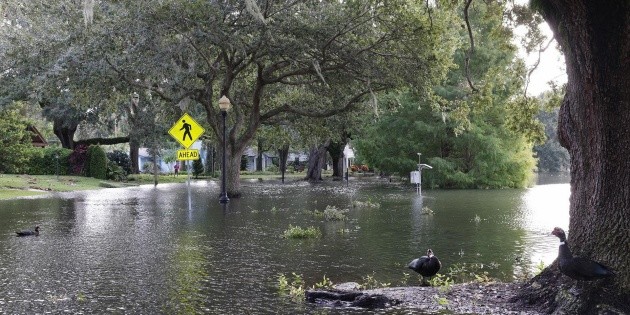Post-tropical cyclone Ian is still producing heavy rains this Saturday as it passes through North Carolina and is expected to continue its journey through Virginia in what are the last throes of a path of destruction through the southeastern United States.
In its latest bulletin dedicated to Ian, the US National Hurricane Center (NHC) noted that the post-tropical cyclone can produce up to 100 milliliters of rain over the center of the Appalachian Mountains, that is, in areas of Tennessee, Kentucky and West Virginia, where flooding and strong gusts of wind can occur.
On the morning of this Saturday, the center of Ian was about 45 kilometers south of Greensboro, North Carolina, and had maximum sustained winds of 55 km / h.
The cyclone was moving over this state to the north-northwest at 19 km / h and, after applying a northward turn, the remnants of Ian are expected to reach southern and central Virginia during the course of this afternoon, according to the NHC .
All warnings in coastal areas associated with Ian have been deactivated, which in central Florida, however, can still produce river overflows this Saturday, as warned by the meteorological center.
After making landfall in Cuba, last Wednesday the eye of Ian reached Florida, as a category 4 hurricane, out of a maximum of 5 on the Saffir-Simpson scale.
CATASTROPHIC IMPACT
After making landfall on Cayo Costa, in southwestern Florida, with maximum sustained winds of 240 km/h, Ian continued through this state where 23 deaths have been recorded so far, according to the coroner’s commission. from Florida, although the CNN network speaks of up to 45 deaths.
“Catastrophic impact,” the fire chief of Fort Myers Beach, a small coastal town devastated by Ian and located in Lee County, in southwestern Florida, which is “ground zero,” summed up in statements to Efe, as State Governor Ron DeSantis acknowledged Friday after a visit to the area.
In Lee and neighboring Charlotte County, authorities and residents today are engaged in recovery efforts amid the devastation; between downed trees and power poles, roads not yet fit for traffic and some like the one that connects the tourist Sanibel with the mainland split in two.
Destroyed was also the two-lane road that connects Pine Island with the colorful town of Matlacha, a fishing town of about 850 people devastated by rising sea levels due to storm surge and where some homes were uprooted and ended up in the water by the winds, as Efe was able to verify.
Neighbors, some of whom have to go by boat to see what remains of their homes, gave accounts of residents who lost their lives trapped in the rubble of their homes.
There, as in the Fort Myers area, recovery efforts continue amid difficulties, as is happening to the residents of the Hidden River community, a part of which may be impacted by the possible breach of a levee, as warned this Saturday the Sarasota County Sheriff’s Office, north of Fort Myers.
In Florida, the Carolinas and Virginia, more than 1.6 million people are without power this Saturday, according to the Poweroutage platform.
A REBUILDING THAT WILL TAKE YEARS
Spokesmen for FPL, the main energy company in Florida, have indicated that they have been able to restore electricity to more than 1.4 million customers, but warned that it will take “weeks” to fully restore electricity. More than 2.6 million people lost power once Ian arrived in Florida.
President Joe Biden authorized the distribution of more federal funds through the issuance of a disaster declaration for Florida, including the areas of the Seminole tribe, as well as for Virginia, while for South Carolina and its neighbor to the North he issued a emergency declaration.
“It will take months, years, the reconstruction. And our hearts go out to all those people whose lives have been absolutely devastated by the storm,” said the president on Friday, who hopes to visit Florida and Puerto Rico, the latter recently impacted. for Hurricane Fiona.
Ian made landfall again in the United States on Friday afternoon as a Category 1 hurricane in Georgetown, South Carolina.
According to the Washington Post, the Insurance Information Institute estimates that Ian’s material losses could exceed $60 billion, the worst record since Hurricane Katrina in 2005.

